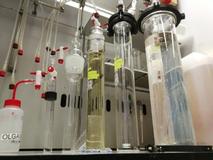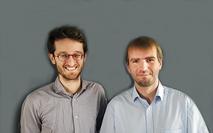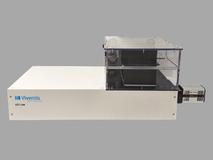Gaia Membranes and Viventis Microscopy win CHF 130,000
28.03.2019
Congratulations to the promising cleantech and medtech startups, who convinced the Venture Kick jury to win CHF 130,000 each!
.jpg) |
 |
 Fabio Oldenburg, co-founder & CTO of Gaia Membranes
|
 Batch Process
|
 |
 |
 Andrea Boni and Petr Strnad, co-founders of Viventis Microscopy
|
 Viventis Microscopy's live-light-sheet-microscope
|
Ion exchange membranes for efficient energy storage, and light-sheet microscopes for live-imaging. These are the two innovations that these startups offer, for a future world using more renewable energy and with a deeper knowledge of how cells function.
Gaia Membranes (ETH Zürich) – Fabio Oldenburg – cleantech
Lithium-ion batteries, the energy storage technology of choice for consumer electronics and electric vehicles, face critical problems such as rapid charge deterioration and short lifetime; a highly-flammable and explosive chemistry; and expensive end-of-life management. Until now, vanadium redox flow batteries (VRFBs) – an emerging technology that scales more easily than Lithium-ion – had struggled to compete because of their relatively low charge-discharge efficiency of 75 percent, compared to nearly 90 percent of lithium-ion batteries.
Gaia Membranes aims to disrupt the status quo and transform VRFBs into the most affordable technology for energy storage. How? Their first ion exchange membrane product boosts the efficiency of VRFBs by up to 15% thus bridging the gap with lithium-ion batteries. What’s more, their versatile membrane technology allows them to develop products that boost the efficiency of fuel cells, water electrolyzers, and other related applications. Which represent some of the fastest-growing segments of the $1.4B market for ion exchange membranes.
Co-founded by inventor Fabio Oldenburg and longtime friend Elian Pusceddu, this spin-off from the Paul Scherrer Institute will develop and manufacture ion exchange membranes through a patent-pending process that will significantly reduce production costs compared to competing materials.
The team is now preparing to increase production and start pilot projects.
"Venture Kick enabled us to transform our idea into a solid business plan and our technology into a product that our customers value. And with the renewed support we can accelerate our manufacturing scale-up and bring our first product to market by the end of 2019."; Elian Pusceddu, Gaia Membrane's co-founder and CEO, said.
www.gaiamembranes.com
Viventis Microscopy (EPFL) – Andrea Boni, Petr Strnad –medtech
High-resolution live-imaging could advance our understanding of many cellular processes. However, we lack microscope systems specifically designed for these challenging experiments. Due to relatively high photo-toxicity, the currently most widespread fluorescence microscopy technology (confocal microscopy) is not suited to long-term imaging of living light-sensitive samples.
Viventis Microscopy started commercializing a novel light-sheet microscope system in August 2018 to address the limitations associated with confocal and current light-sheet microscopes. Viventis Microscopy delivers the hardware and custom microscope control software for long-term, live-imaging of light-sensitive samples, such as embryos and organoids.
Viventis has already delivered several microscope systems to leading European institutes and is entering a $750 million imaging market currently served by fluorescence confocal microscopy. Viventis plans to expand in the biotech and pharma segments that use 3D culture systems such as organoids in their research.
The company aims to establish itself as a strong, innovative player in the field of live-cell imaging in Europe this year, and prepare entry into global markets via the U.S., Japan and Singapore from 2020.
"Venture Kick will allow us to finance our demo microscope and bring it to potential customers and to international exhibitions. This is fundamental to increase our visibility and market penetration." Andrea Boni, Viventis Microscopy's co-founder and COO, said.
www.viventis-microscopy.com
Gaia Membranes (ETH Zürich) – Fabio Oldenburg – cleantech
Lithium-ion batteries, the energy storage technology of choice for consumer electronics and electric vehicles, face critical problems such as rapid charge deterioration and short lifetime; a highly-flammable and explosive chemistry; and expensive end-of-life management. Until now, vanadium redox flow batteries (VRFBs) – an emerging technology that scales more easily than Lithium-ion – had struggled to compete because of their relatively low charge-discharge efficiency of 75 percent, compared to nearly 90 percent of lithium-ion batteries.
Gaia Membranes aims to disrupt the status quo and transform VRFBs into the most affordable technology for energy storage. How? Their first ion exchange membrane product boosts the efficiency of VRFBs by up to 15% thus bridging the gap with lithium-ion batteries. What’s more, their versatile membrane technology allows them to develop products that boost the efficiency of fuel cells, water electrolyzers, and other related applications. Which represent some of the fastest-growing segments of the $1.4B market for ion exchange membranes.
Co-founded by inventor Fabio Oldenburg and longtime friend Elian Pusceddu, this spin-off from the Paul Scherrer Institute will develop and manufacture ion exchange membranes through a patent-pending process that will significantly reduce production costs compared to competing materials.
The team is now preparing to increase production and start pilot projects.
"Venture Kick enabled us to transform our idea into a solid business plan and our technology into a product that our customers value. And with the renewed support we can accelerate our manufacturing scale-up and bring our first product to market by the end of 2019."; Elian Pusceddu, Gaia Membrane's co-founder and CEO, said.
www.gaiamembranes.com
Viventis Microscopy (EPFL) – Andrea Boni, Petr Strnad –medtech
High-resolution live-imaging could advance our understanding of many cellular processes. However, we lack microscope systems specifically designed for these challenging experiments. Due to relatively high photo-toxicity, the currently most widespread fluorescence microscopy technology (confocal microscopy) is not suited to long-term imaging of living light-sensitive samples.
Viventis Microscopy started commercializing a novel light-sheet microscope system in August 2018 to address the limitations associated with confocal and current light-sheet microscopes. Viventis Microscopy delivers the hardware and custom microscope control software for long-term, live-imaging of light-sensitive samples, such as embryos and organoids.
Viventis has already delivered several microscope systems to leading European institutes and is entering a $750 million imaging market currently served by fluorescence confocal microscopy. Viventis plans to expand in the biotech and pharma segments that use 3D culture systems such as organoids in their research.
The company aims to establish itself as a strong, innovative player in the field of live-cell imaging in Europe this year, and prepare entry into global markets via the U.S., Japan and Singapore from 2020.
"Venture Kick will allow us to finance our demo microscope and bring it to potential customers and to international exhibitions. This is fundamental to increase our visibility and market penetration." Andrea Boni, Viventis Microscopy's co-founder and COO, said.
www.viventis-microscopy.com


